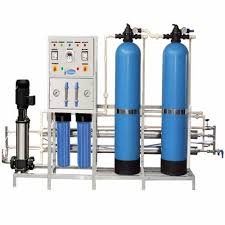
RO Plant, Reverse Osmosis Plant, Industrial RO System, Water Filtration Plant Manufacturer, Exporter in Pune, India We are Manufacturer, Supplier, Exporter, Consultants (and also Installation, Commissioning, Consultancy Services Provider) of Industrial Reverse Osmosis Plants, Industrial RO Plants, Turnkey Projects from Pune, Maharashtra, India. We also provide AMC (Annual Maintenance Contract) Services, O&M (Operation & Process Maintenance) Services.
When the water molecules pass through the membrane under very high pressure, they pass through it, and salts or contaminants hold back. They get discharged through the system by the reject stream. Rejected water may be drained out or sent to the feed water supply, depending on the design. RO systems use cross-filtration and not the standard filtration where the contaminants get accumulated in the filter media. In this case, the solution passes through the filter in two different ways. Contaminated water goes in one direction and filtered water in the other. Cross-flow filtration cleans the contaminant buildup so that the membrane surface remains clean.
Reverse Osmosis (commonly referred to as RO) is the process of deionizing or demineralizing water by passing it through a semi-permeable membrane. Before understanding the effectiveness and need of the Reverse Osmosis process, let’s understand the process of Osmosis first. When the weaker saline solution migrates to a strong saline solution, it is called Osmosis. It is a commonly occurring phenomenon in nature with a variety of uses and applications. Our kidneys absorb water from the blood or plant roots absorb water from the soil are some examples. Reverse Osmosis is the process in a reverse manner. Whereas the Osmosis process occurs naturally without any need for energy, you need to apply energy to perform Reverse Osmosis. The membrane used in this case allows the water molecules to pass but stops the majority of the salts and impurities dissolved in the water. Typically, it stops organic material, salts, pyrogens, and bacteria. Since it is against natural processes, you need to put a lot of energy into pushing the water through the RO membrane. It desalinates the water, lets the pure water pass through the membrane, and holds back the majority of contaminants. Statistics say that up to 95 to 99 percent of dissolved salts get removed in the process. The more salt concentration is there in the input water stream; the higher the pressure required to pass it through the membrane.